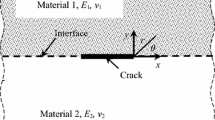Abstract
The sub-interfacial crack growth in bi-materials is numerically studied in this paper using the extended finite element method (X-FEM), which gives a clear description of the effect on fracture which is made by the interface and loading condition. Computational results are compared with the experiment data, which demonstrates that X-FEM is more powerful to capture the actual crack growing path than the standard FEM. Further researches show that there exists an equilibrium state which forms a mode-I crack growth in bi-materials. An empirical formula is proposed which quantitatively reveals the influence of material inhomogeneity, loading asymmetry and location of the initial crack on this state.
Similar content being viewed by others
References
Areias PMA, Belytschko T (2006) Two-scale shear band evolution by local partition of unity. Int J Numer Meth Eng 66: 878–910
Belytschko T, Black T (1999) Elastic crack growth in finite elements with minimal remeshing. Int J Numer Meth Eng 45: 601–620
Chessa J, Belytschko T (2003) An extended finite element method for two-phase fluids. J Appl Mech 70(1): 10–17
Hutchinson JW, Mear ME, Rice JR (1987) Crack parallel an interface between dissimilar materials. ASME J Appl Mech 54: 828–832
Karihaloo BL, Liu XY, Xiao QZ (2004) Extended finite element method for direct evaluation of mixed mode stress intensity factors in homogeneous and bimaterials. Int J Numer Meth Eng 59: 1103–1118
Karihaloo BL, Xiao QZ (2003) Modelling of stationary and growing cracks in FE framework without remeshing: a state-of-the-art review. Comput Struct 81: 119–129
Karihaloo BL, Xiao QZ (2006) Improving the accuracy of XFEM crack tip field using higher order quadrature and statically admissible stress recovery. Int J Numer Meth Eng 66: 1378–1410
Lee H, Krishnaswamy S (2000) Quasi-static propagation of sub-interfacial cracks. ASME J Appl Mech 67: 444–452
Marsavina L, Piski T (2010) Bimaterial four point bend specimen with sub-interface crack. Int J Fract 164: 325–332
Moes N, Belytschko T (2002) Extended finite element method for cohesive crack growth. Eng Fract Mech 69: 813–833
Moes N, Dolbow J, Belytschko T (1999) A finite element method for crack growth without remeshing. Int J Numer Meth Eng 46: 131–150
Song JH, Areias PMA, Belytschko T (2006) A method for dynamic crack and shear band propagation with phantom nodes. Int J Numer Meth Eng 67: 868–893
Venkatesha KS, Ramamurthy TS, Dattaguru B (1998) A study of the behaviour of subinterface cracks in bi-material plates. Eng Fract Mech 59: 241–252
Yang M, Kim K (1992) The behaviour of subinterface cracks with crack-face contact. Eng Fract Mech 44: 155–165
Zhuang Z, Cheng BB (2011) Development of X-FEM methodology and study on mixed-mode crack propagation. Acta Mech Sin (in press)
Author information
Authors and Affiliations
Corresponding author
Rights and permissions
About this article
Cite this article
Zhuang, Z., Cheng, B.B. Equilibrium state of mode-I sub-interfacial crack growth in bi-materials. Int J Fract 170, 27–36 (2011). https://doi.org/10.1007/s10704-011-9599-5
Received:
Accepted:
Published:
Issue Date:
DOI: https://doi.org/10.1007/s10704-011-9599-5




